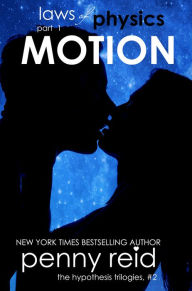[PDF] Motion: (Law of Physics #1) by Penny Reid
Par browning gene le samedi, juin 19 2021, 10:42 - Lien permanent
Motion: (Law of Physics #1) by Penny Reid


- Motion: (Law of Physics #1)
- Penny Reid
- Page: 200
- Format: pdf, ePub, mobi, fb2
- ISBN: 9781635763393
- Publisher: EverAfter Romance
Download japanese textbook free Motion: (Law of Physics #1) English version
Newton's First Law of Motion: Examples of the Effect of Force on This lesson describes Newton's first law of motion, also known as the law of inertia. The interaction between force and Newton's First Law: Physics Lab. Overview of Newton's Second . the clay to change its shape. In this lesson, we will explore the relationship between force and motion as explained by Newton'slaws.
Chapter 7 Newton's Laws of Motion, Sections 7.1-7.4 7-1. Chapter 7 Newton's Laws of Motion. I have not as yet been able to discover the reason for these properties of gravity from phenomena, and I do not feign ..motion in physics. Law II: The change of motion is proportional to the motive force impressed, and is made in the direction of the right line in which that force.
Motion: (Law of Physics #1) - Livros na Amazon Brasil Compre o livro Motion: (Law of Physics #1) na Amazon.com.br: confira as ofertas para livros em inglês e importados.
Investigating Newton's second law of motion - Practical Physics The force is conveniently increased in 1 newton steps when slotted masses of 100 g are added. Place the unused slotted masses on the trolley. Transfer them to the slotted mass holder each time the accelerating force is increased. This ensures that the total mass experiencing acceleration remains constant throughout the
Newton's First Law - The Physics Classroom The focus of Lesson 1 is Newton's first law of motion - sometimes referred to as the law of inertia. An object at rest stays at rest and an object in motion stays in motion with the same speed and in the same direction unless acted upon by an unbalanced force.
Newton's Second Law - The Physics Classroom Newton's second law of motion pertains to the behavior of objects for which all existing forces are not balanced. The second law states that the Comparing the values in rows 1 and 2, it can be seen that a doubling of the net force results in a doubling of the acceleration (if mass is held constant). Similarly, comparing the
Inertia and Mass - The Physics Classroom Newton's Laws - Lesson 1 - Newton's First Law of Motion Newton's first law ofmotion states that "An object at rest stays at rest and an object in motion stays inmotion with the same speed and in the same direction unless acted Newton's first law of motion declares that a force is not needed to keep an object in motion.
Newton's Laws of Motion - 1. Force and Inertia - ISTP - NASA generous to others, bestowing his attention not just on physics and mathematics, but also on religion and alchemy. The one thing about which everyone agrees is his brilliant talent. Three problems intrigued scientists in Newton's time: the laws of motion, the laws of planetary orbits, and the mathematics of
Newton's laws of motion - Wikipedia Newton's laws of motion are three physical laws that, together, laid the foundation for classical mechanics. They describe the relationship between a body and the forces acting upon it, and its motion in response to those forces. More precisely, the first law defines the force qualitatively, the second law offers a quantitative
Newton's Laws of Motion Quiz - Softschools.com Sir Isaac Newton developed three laws of motion that govern classical physics. The laws are as follows: 1. An object in motion stays in motion unless acted on by an outside force. This same rule applies to objects at rest. This is called the Law of Inertia. 2. Acceleration comes from when a force acts on an object with mass.
Newton's 3 Laws of Motion - Teachertech.rice.edu… Sir Isaac Newton · First Law of Motion · Second Law of Motion · Third Law ofMotion · Review Newton's Laws · Quiz · Quiz Answers · Hot Wheels Lab · Balloon Racers · Georgia Louviere 10/24/06. Surfing the Net with Kids.
Newton's third law of motion (practice) | Khan Academy When you step on a roach, the roach applies an equal and opposite force on your foot as your foot applies to the roach (we don't advocate killing insects this way, especially if you are barefoot). Choose 1 answer: Choose 1 answer: A. True. B. False. Stuck? Watch a video or use a hint. Report a problem. Created with
Lesson 1 - Newton's First Law of Motion - The Physics Classroom 1-D Kinematics · Newton's Laws · Vectors - Motion and Forces in Two Dimensions · Momentum and Its Conservation · Work, Energy, and Power · Circular Motion and Satellite Motion · Thermal Physics · Static Electricity · Current Electricity · Waves · Sound Waves and Music · Light Waves and Color · Reflection and the Ray
Other ebooks: [PDF/Kindle] Loba negra by Juan Gómez-Jurado download link, [PDF/Kindle] Training Guide: Configuring Advanced Windows Server 2012 R2 Services by Orin Thomas here,